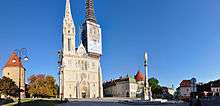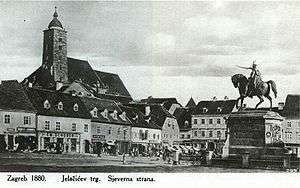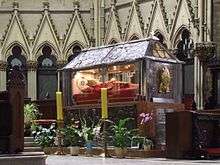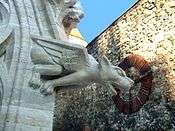Zagreb Cathedral
| Zagreb Cathedral | |
|---|---|
| Cathedral of the Assumption of Mary | |
| Croatian: Zagrebačka katedrala | |
 | |
 Zagreb Cathedral | |
| 45°48′52″N 15°58′47″E / 45.81444°N 15.97972°ECoordinates: 45°48′52″N 15°58′47″E / 45.81444°N 15.97972°E | |
| Location | Zagreb |
| Country | Croatia |
| Denomination | Roman Catholic |
| History | |
| Relics held | Sarcophagus of Blessed Aloysius Stepinac |
| Architecture | |
| Status | Cathedral |
| Functional status | Active |
| Heritage designation | Register of Cultural Goods of Croatia |
| Designated | 2013 |
| Architect(s) | Hermann Bollé (last reconstruction) |
| Style |
Gothic (original) Gothic Revival (19th century reconstructions) |
| Years built |
Mid-13th century 1880–1906 (reconstruction/additions) |
| Specifications | |
| Number of spires | 2 |
| Spire height | 108 m (354 ft) |
| Bells |
5 (North Tower) 3 (South Tower)[1] |
| Administration | |
| Archdiocese | Zagreb |
| Clergy | |
| Archbishop | Josip Bozanić |
|
Native name Croatian: Zagrebačka katedrala | |
| Location | Zagreb, Croatia |
| Governing body | Zagrebačka katedrala |
| Type | Cultural |
| Designated | March 9, 2013[2] |
The Zagreb Cathedral on Kaptol is a Roman Catholic institution and not only the tallest building in Croatia, but also the most monumental sacral building in Gothic style southeast of the Alps.[3] It is dedicated to the Assumption of Mary and to kings Saint Stephen and Saint Ladislaus. The cathedral is typically Gothic, as is its sacristy, which is of great architectural value. Its prominent spires are considered to be landmarks as they are visible from most parts of the city.
History
In 1093 when king Ladislaus (1040-1095) moved the bishop's chair from Sisak to Zagreb, he proclaimed the existing church as a cathedral. Construction on the cathedral started shortly after his death and was finished in 1217 and consecrated by king Andrew II of Hungary. The building was destroyed by the Mongols in 1242 but rebuilt by bishop Timotej (1263-1287) a few years later. At the end of the 15th century, the Ottoman Empire invaded Croatia, triggering the construction of fortification walls around the cathedral, some of which are still intact. In the 17th century, a fortified renaissance watchtower was erected on the south side, and was used as a military observation point, because of the Ottoman threat.
The cathedral was severely damaged in the 1880 Zagreb earthquake. The main nave collapsed and the tower was damaged beyond repair. The restoration of the cathedral in the Neo-Gothic style was led by Hermann Bollé, bringing the cathedral to its present form. As part of that restoration, two spires 108 m (354 ft) high were raised on the western side, both of which are now in the process of being restored as part of an extensive general restoration of the cathedral.
The cathedral is depicted on the reverse of the Croatian 1000 kuna banknote issued in 1993.[4]
When facing the portal, the building is 46 meters wide and 108 meters high.[5] The cathedral contains a relief of Cardinal Aloysius Stepinac with Christ done by the Croatian sculptor Ivan Meštrović. The cathedral was visited by Pope Benedict XVI on 5 June 2011 where he celebrated Sunday Vespers and prayed before the tomb of Blessed Aloysius Stepinac.
Gallery
 1880 pre-earthquake view from Jelačić Square with old square spire
1880 pre-earthquake view from Jelačić Square with old square spire.jpg) 19th Century view with fortifications intact
19th Century view with fortifications intact- Facade
- Mary column in front of the Cathedral
- Entrance portal
 Eastern view
Eastern view
 Nave, altar and pulpit
Nave, altar and pulpit Gargoyle on a Zagreb Cathedral
Gargoyle on a Zagreb Cathedral Zagreb skyline with cathedral in the background
Zagreb skyline with cathedral in the background Neo-Gothic tower on a Zagreb Cathedral
Neo-Gothic tower on a Zagreb Cathedral- Lateral interior
- Stained glass
- Interior nave
- Coffin
- Altar
See also
References
- ↑ "Zvona zagrebačke katedrale (Bells of the Zagreb Cathedral)". Glas Koncila (in Croatian).
- ↑
- ↑ Feđa Gavrilović (12 January 2012). "Razbijene zastarjele predrasude" [Obsolete prejudices shattered. Vijenac (in Croatian) (Matica hrvatska) (466). ISSN 1330-2787. Retrieved 29 June 2012.
- ↑ Croatian National Bank. Features of Kuna Banknotes: 1000 kuna. – Retrieved on 30 March 2009.
- ↑ MAKOV TEKST O ZAGREBAČKOJ KATEDRALI - glas-koncila.hr
External links
| Wikimedia Commons has media related to Zagreb Cathedral. |
- Zagreb Cathedral; Zagreb Tourist Info
- Zagrebačka katedrala (Croatian)
- "Đavlova glava u zagrebačkoj katedrali" (Croatian)
- Zagreb cathedral in the 1880 earthquake and its present day renovation (Croatian)
